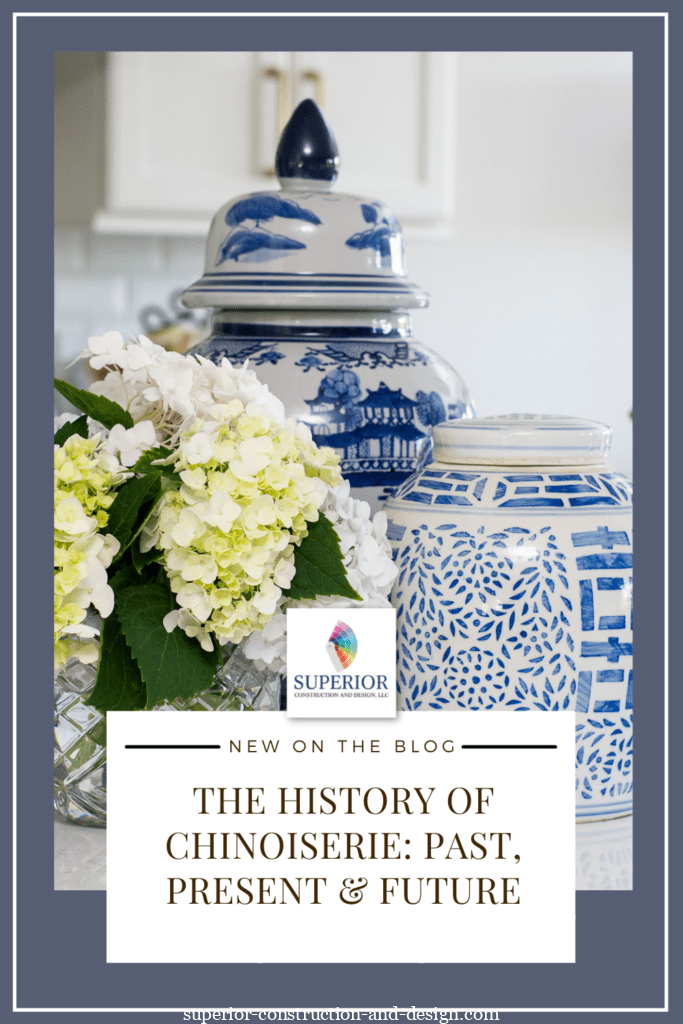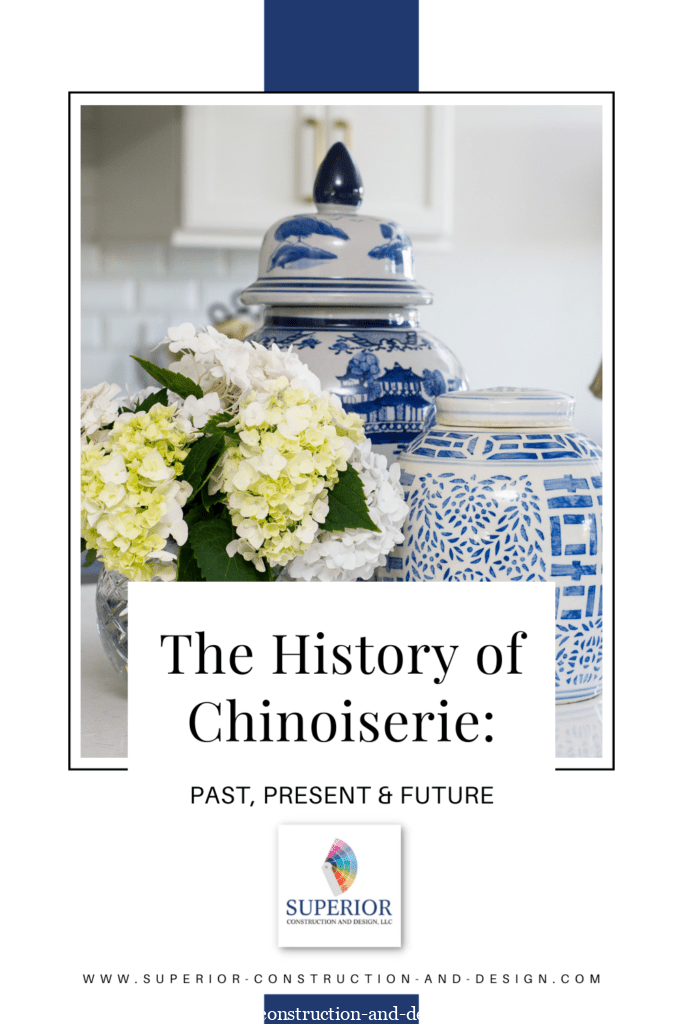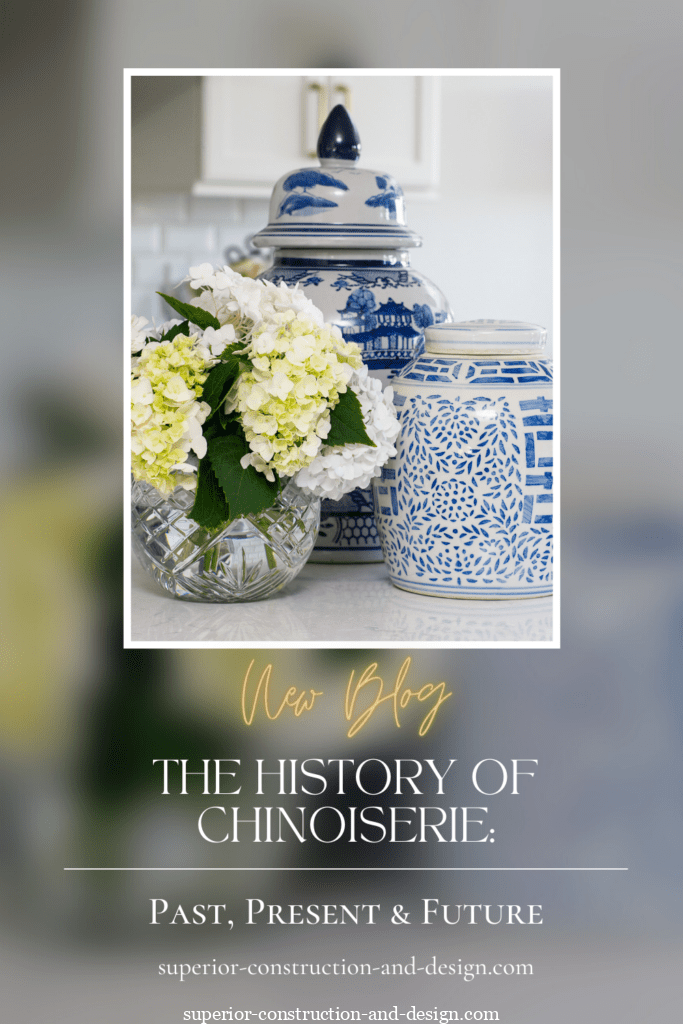The History of Chinoiserie: Past, Present & Future
October 25th, 2022 | by Elizabeth| Posted in color, design, home & gardenIf y’all have been around here for longer than a month or two, you’ve probably heard me talk about chinoiserie. I don’t say this about many things, but I am obsessed with it. As a designer, these pieces are timeless classics that make a space look good!
But even before I was designing homes, I was drawn to chinoiserie. I clearly remember this one particular catalog, way back, that I loved. It had lots of Asian-inspired home decor items for sale. This was 31 years ago, right around the time that my husband and I had gotten married. His only request was, “I don’t care what you do, I just don’t want flowers on my bedspread.”
Sounds like free rein to me. I honored that request and ordered a set of chinoiserie-inspired pillows for our sofa. They were white, gold, and beautiful, with Chinese characters on them (although chinoiserie isn’t really Chinese, as you’ll soon find out!). I never knew what they said, but I loved them for years.
Fast forward a few decades, and I’ve since collected more chinoiserie than I care to admit! I’ve also put it in several client projects, like our Lake House client’s kitchen…
…and I’ve followed chinoiserie’s rising popularity in more recent years, like this chinoiserie-inspired fridge at KBIS 2020 and the chinoiserie-inspired wallpaper and lamps found at High Point Market 2021:
What a variety! Despite all this, I didn’t know the true history of chinoiserie until recently. (Love is blind, right?) But now that I do know its fascinating history, I feel compelled to share it with you. Where did it start? Where is it going? I think you’ll be as surprised as I was…
Where did chinoiserie start?
To tell the tale, we have to start with Dr. Aldous Bertram, an interior designer with a PhD in Chinoiserie from Cambridge University. You read that right…he has a doctorate in chinoiserie. How cool is that?? Aldous is also the author of Dragons & Pagodas: A Celebration of Chinoiserie. Yes, I have this book (of course I do) and it is FABULOUS!! If you love chinoiserie and you’re looking for a coffee table book, this is it.
Okay, back to history, as told by Dr. Bertram in this House Beautiful article…
Picture 17th century Europe. At the time, baroque style was all the rage. Furniture was intricately carved, art was ornamental and dramatic, and rooms were sumptuously designed. As with any era of design, it wouldn’t last forever. Soon, people were craving something new and fresh. (Y’all know all about that, I bet!)
Enter, porcelain and lacquer, introduced by European explorers who were returning from voyages east. With these never-before-seen materials and stories of a vastly different culture, you guessed it, the sensation began. Europe became obsessed with Asian culture, and chinoiserie, porcelain vases painted with scenes from the East, emerged.
According to Dr. Bertram, chinoiserie’s rising popularity reached its tipping point in 1671, when King Louis XIV built the Trianon de Porcelaine at the Palace of Versailles. It was a true spectacle composed of blue-and-white chinoiserie tiles…and the world loved it! Although the Trianon de Porcelaine was torn down in 1687, it launched chinoiserie’s popularity throughout Europe — a trend that would last over 100 years! (Source)
In the 19th century, chinoiserie slowly started to phase out of the public eye, but it has since experienced a revival in interiors and fashion today. I’m all for that!
Why isn’t chinoiserie Chinese?
Despite its prevalence throughout the centuries, would you believe that chinoiserie isn’t actually Chinese? This surprised me too, and there’s a good reason. Dr. Bertram says that, at best, chinoiserie has roots in Asian influence. Why? Because when European explorers returned with stories of the East, details were shared by word-of-mouth, there was little Western differentiation between China and Japan, and accuracy was lost.
So chinoiserie became something new, a European invention based on what the people of the time wanted to see, not on truth. In fact, some critics of the time thought chinoiserie ridiculed Eastern culture! (Source)
They may well have been right, but in modern times, and thanks to people like Dr. Bertram, we have more information and cultural awareness than ever before. We can love chinoiserie, understand that it’s not a representation of our Eastern neighbors, and be respectful of other cultures all at the same time!
Chinoiserie vessel holding tulips in my bathroom. This wallpaper probably also has roots in Chinese influence, but that’s research for another day!
What is the future of chinoiserie?
Popularity has definitely been rising this century, but I can’t tell you how long it will last. All I know is that pieces that come in and out of style over and over again (versus disappear) are usually timeless. And even if it’s not, if you love something, it will always be in style in your home. And speaking of, I couldn’t resist pulling together some of my favorites…
Chinoiserie-Inspired Home Decor
1. Ginger Jar, perfect for an entryway table to set the tone for your classic style home
2. Mini Ornaments, great for gifting or for styling on shelves and bookcases
3. Table Lamps, for a serene touch on bedside tables
4. Wallpaper, perfect for a playful powder room or behind shelving
5. Pillow, add it as a finishing touch to your sofa or patio chair (yes, it’s good for all seasons!)
6. Luxury Plastic Plates, for entertaining in style (and peace of mind)
7. Ceramic Garden Stool, perfect as a plant stand, a table by the sofa, or additional seating.
Oh, and the Dragons & Pagodas book! It is seriously stunning. You won’t regret it. Well, that’s all for now, but if you’re looking to add some personalized style to your home, chinoiserie-inspired or not, you know where to find me! My team and I can’t wait to hear about your project.
Xo,
E
Note: If you the affiliate links in this blog post to purchase any of these items, I may make a small commission at no extra cost to you. Thank you for supporting our business!







I loved reading this article. And your selections are beautiful. Thank you.
Thanks Jessica!